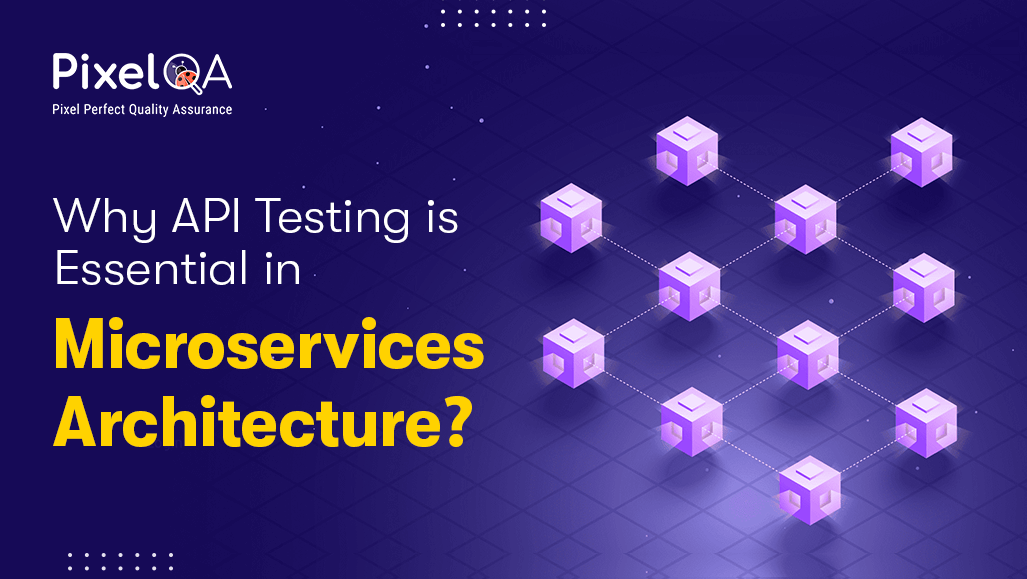
The growing trend in microservices architecture has dramatically changed the way applications are built and scaled. In devices that use microservices, the software is divided into smaller services. Impartial Each service focuses on specific business features. These offerings are differentiated through an API (software programming interface) that serves as a bridge for exchanging information and incentive strategies. Meanwhile, this structure also offers great benefits in terms of flexibility. Scalability and flexibility also pose new challenges. API testing services are one of the most important elements to ensure a smooth rollout of microservices. Each microservice depends closely on an API to interact with one another. If the API doesn't work properly, all equipment can get lost underneath. API efforts help ensure that interactions are reliable and meet required performance standards. In this blog, we'll explore why using APIs is critical to shaping microservices. And how to ensure a clean and robust machine.
Table of Contents
- What is Microservices Architecture?
- Importance of API Testing in Microservices Architecture
- Key Challenges in API Testing for Microservices
- Types of API Testing in Microservices
- Tools for API Testing in Microservices
- Automation in API Testing for Microservices
- Challenges in API Testing
- Best Practices for API Testing in Microservices
- Conclusion
What is Microservices Architecture?
Microservices represent a strategic architectural and organizational method for software development. This approach includes constructing software from small, autonomous offerings that have interaction via without a doubt defined APIs. Each carrier is controlled by a devoted, self-sufficient group.
The microservices structure simplifies scaling and hastens improvement, fostering innovation and reducing the time required to introduce new functions to the market. Internet API checking out plays a critical position in making sure that those services engage efficiently, verifying their integration, and ensuring they function as intended within the machine.
Importance of API Testing in Microservices Architecture
1: Ensuring Smooth Integration:
API testing confirms the seamless integration of microservices by validating data exchanges and communication channels. By evaluating service interoperability, API testing services enhance the coherence and stability of the microservices architecture. Whether you're testing RESTful APIs through web API testing or SOAP-based services via SOAP API testing, the goal remains to ensure smooth communication and efficient data flow.
2: Isolation and Validation of Microservices:
API testing enables comprehensive validation of each microservice to ensure it performs its intended function accurately. By isolating testing scenarios, issues can be precisely identified and resolved at the microservice level. Web API testing and SOAP API testing help to test the APIs in isolation to confirm their correct functionality, whether it's validating responses from RESTful APIs or checking the structure of SOAP requests and responses.
3: Data Consistency and Fault Tolerance:
API testing ensures that data remains consistent and accurate across microservices. It validates that updates in one microservice are correctly reflected in others, preventing discrepancies and maintaining application coherence. Additionally, it assesses fault tolerance by simulating failures such as service outages or network issues, ensuring robust error handling and system resilience. Both web API testing and SOAP API testing ensure that the system handles these issues across different API protocols, improving reliability.
4: Performance, Scalability, and End-to-End Functionality:
API testing identifies overall performance bottlenecks and ensures the efficient operation of microservices under various loads. Scalability checks help enhance the responsiveness and scalability of the microservices structure. Furthermore, end-to-end testing scenarios validate the integrated behavior of the entire system, offering a holistic view of the microservices ecosystem and confirming seamless functionality. Both web API testing and SOAP API testing are essential for checking how different services scale and perform under pressure.
5: Security and Stability Assurance:
Tests against the API incorporate in-depth security assessments to pinpoint vulnerabilities, such as injection, unauthorized access, and data breach possibilities. In this way, security-related microservices can be effectively and reliably protected against possible threats. Furthermore, contract tests such as those offered by Pact check that changes in one microservice will not harm others' real advantage for stability within the microservices architecture. Both API testing for the Web and SOAP API will work toward validating the security control measures and ensuring that solid access controls are in place.
Key Challenges in API Testing for Microservices
1: Communication Complexity:
The complexity arises from multiple services communicating via APIs. Ensuring seamless integration involves verifying data transmission accuracy, effective error handling, and adherence to proper message formats across these APIs, which is a significant testing challenge.
2: Service dependencies
Service dependencies in microservices architecture often require different services to collaborate to deliver comprehensive functionality. This mutual reliance presents testing challenges, emphasizing the need to verify each service’s functionality both independently and when integrated with others.
3: Data Consistency:
Ensuring consistent data across diverse services is intricate. Testing scenarios involving transactions across multiple services while maintaining data integrity requires meticulous consideration and planning.
4: Scalability and Load Testing:
Microservices’ independent scalability necessitates rigorous testing of system response under varied loads. Coordinating these tests and assessing the impact of scaling on different services poses considerable challenges.
Types of API Testing in Microservices
1. Unit Testing:
Objective: Validate the functionality of individual microservices in isolation.
Approach: Use mocks or stubs to simulate external dependencies and ensure each microservice performs as intended.
2. Integration Testing:
Objective: Verify the seamless integration of multiple microservices.
Approach: Test the interactions between microservices, ensuring they work cohesively.
3. End-to-End Testing:
Objective: Validate the entire microservices architecture, covering all business processes.
Approach: Simulate real-world scenarios to ensure the integrated system behaves as expected.
4. Contract Testing:
Objective: Ensure that contracts between microservices, specifying how they interact, are honored.
Approach: Use tools like Pact to verify that changes in one microservice do not break functionality in others.
Tools for API Testing in Microservices
1. Postman: A versatile tool for manually testing APIs and creating automated test scripts.
2. RestAssured: A Java library widely used for testing RESTful APIs, suitable for automated testing.
3. Pact: A contract testing tool that helps ensure microservices adhere to their agreements.
4. JUnit/TestNG: Popular testing frameworks for writing and executing unit and integration tests.
5. Docker: Facilitates containerization, enabling the creation of isolated testing environments.
Automation in API Testing for Microservices
- Embrace automation to handle the complexity of microservices architecture.
- Integrate API tests into continuous integration pipelines for early detection of issues.
1: Documentation and Collaboration
- Maintain clear and updated API documentation.
- Foster collaboration between development and testing teams to ensure alignment on API specifications.
2: Monitoring and Logging
- Implementation of robust monitoring and logging mechanisms is critical. API testing contributes to proactive issue identification, allowing for quick resolution and contributing to the overall stability of the microservices environment.
Challenges in API Testing
- Distributed nature: Testing across multiple services and environments can be complex.
- API documentation: Outdated or incomplete documentation hinders effective testing.
- Mock dependencies: Mocking external services for isolation can be challenging.
- Test automation: Efficient automation is crucial for managing the large number of API tests.
Best Practices for API Testing in Microservices
- Shift-left testing: Integrate testing early in the development lifecycle.
- API documentation tools: Use tools like Swagger to generate and maintain API documentation.
- Contract-driven development: Define and enforce API contracts for collaboration and consistency.
- Mocking and virtualization: Utilize tools like Mockito or WireMock to simulate dependencies.
- API testing frameworks: Leverage tools like Postman, SoapUI, or Rest Assured for efficient testing.
- Test automation: Automate repetitive tests for faster feedback and continuous integration.
Conclusion
API testing inside the realm of microservices is a dynamic and multifaceted undertaking. By adopting a comprehensive trying-out method that encompasses unit trying out, integration testing, end-to-end trying out, and contract trying out, organizations can ensure the seamless operation of their microservices structure. Partnering with a software testing company can further strengthen these efforts by providing expertise and resources tailored to complex testing needs. Leveraging tools and automation not only complements efficiency but also contributes to the reliability and scalability of microservices-based total packages.
As microservices strive to adapt, a continuous commitment to refining, adapting, and trying out practices is paramount. Include the challenges, stay vigilant in tracking, and let API testing be the cornerstone of a resilient, high-performance microservices ecosystem. In doing so, you pave the way for a evidence-based and dependable software structure.
About Author
 Ashok Makwana is a seasoned Quality Assurance professional with a passion for continuous learning. He started his journey as a QA in September 2020 and embraced challenges as opportunities for growth. His drive to excel led him to aspire to become a Lead QA Manager, exemplifying dedication and expertise in his field. With a proactive approach and a thirst for knowledge, Ashok Makwana embodies the spirit of lifelong learning and achievement in quality assurance.
Ashok Makwana is a seasoned Quality Assurance professional with a passion for continuous learning. He started his journey as a QA in September 2020 and embraced challenges as opportunities for growth. His drive to excel led him to aspire to become a Lead QA Manager, exemplifying dedication and expertise in his field. With a proactive approach and a thirst for knowledge, Ashok Makwana embodies the spirit of lifelong learning and achievement in quality assurance.

_638711415294434027.png)